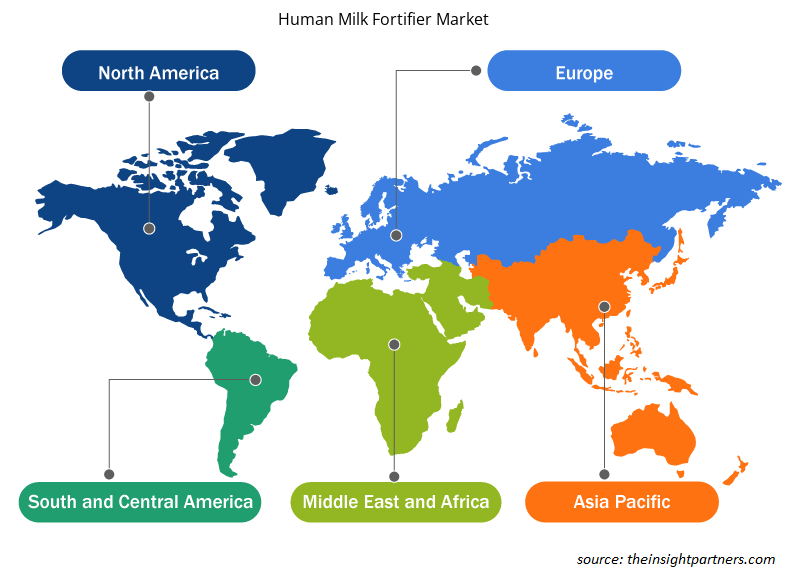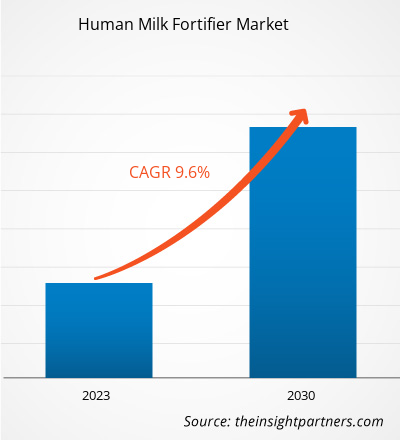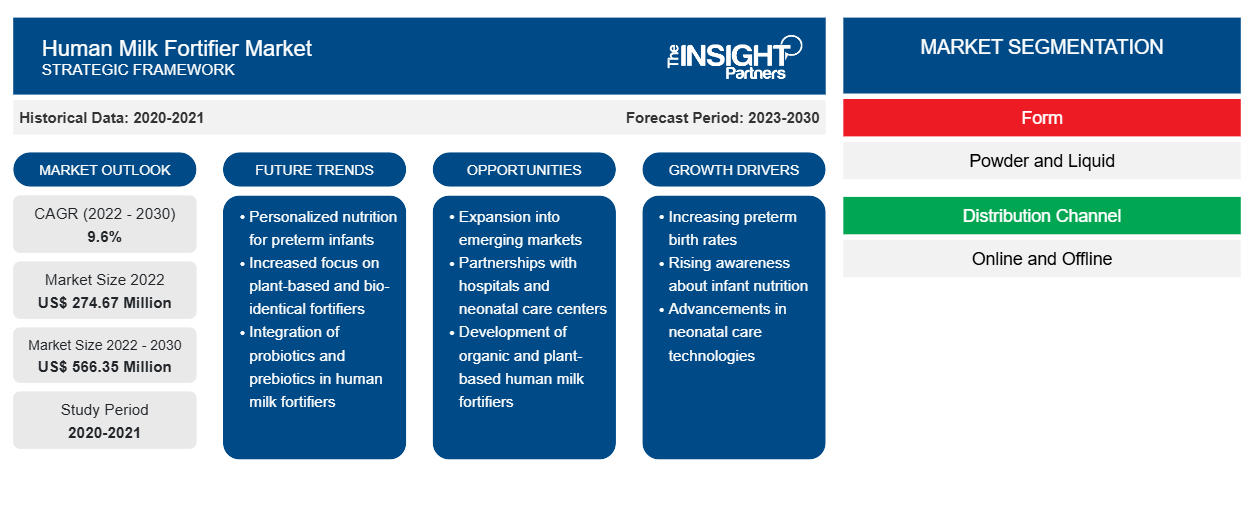[Forschungsbericht] Der Markt für Muttermilchanreicherungsmittel soll von 274,67 Millionen US-Dollar im Jahr 2022 auf 566,35 Millionen US-Dollar im Jahr 2030 wachsen; von 2023 bis 2030 wird eine durchschnittliche jährliche Wachstumsrate (CAGR) von 9,6 % erwartet.
Markteinblicke und Analystenansichten:
Muttermilchanreicherungsmittel sind Nahrungsergänzungsmittel, die der Muttermilch zugesetzt werden, um Säuglingen zusätzliche Kalorien, Elektrolyte und Vitamine zuzuführen. Sie werden häufig Frühgeborenen auf der Neugeborenen-Intensivstation ( NICU ) verschrieben, um die Nährstoffaufnahme sicherzustellen und die allgemeine Entwicklung und das Wachstum zu verbessern. Darüber hinaus werden auch Säuglingen mit geringem Gewicht Muttermilchanreicherungsmittel verschrieben.
Wachstumstreiber und Herausforderungen:
In den letzten Jahren ist die Zahl der Frühgeburten aufgrund veränderter Lebensstile und chronischer Krankheiten wie Diabetes und Bluthochdruck gestiegen. Nach Angaben der Centers for Disease Control and Prevention (CDC) war im Jahr 2021 etwa jedes zehnte in den USA geborene Kind von einer Frühgeburt betroffen. Die Frühgeburtenrate in den USA stieg von 10,1 % im Jahr 2020 auf 10,5 % im Jahr 2021. Die Weltgesundheitsorganisation (WHO) schätzt, dass im Jahr 2020 etwa 13,4 Millionen Babys geboren wurden. Die Frühgeburtskomplikation ist die häufigste Todesursache bei Kindern unter fünf Jahren und war im Jahr 2019 für etwa 900.000 Todesfälle verantwortlich. Frühgeborene können Atemprobleme, Fütterungsschwierigkeiten, Entwicklungsverzögerungen, Zerebralparese sowie Seh- und Hörprobleme haben.
Die steigende Zahl von Frühgeburten hat die Nachfrage nach Muttermilchanreicherungsmitteln für das richtige Wachstum und die Entwicklung von Säuglingen in die Höhe getrieben. Viele Frühgeborene benötigen zusätzliche Nährstoffe in der Muttermilch. Sie benötigen oft zusätzliches Eiweiß, Kalzium, Phosphor und Salz, um starke Knochen und gesunde Organe aufzubauen. Muttermilchanreicherungsmittel helfen dabei, Säuglinge mit diesen zusätzlichen Nährstoffen zu versorgen. Bei Muttermilchanreicherungsmitteln werden der Milch zusätzliche Nährstoffe zugesetzt, bevor sie den Babys gegeben wird. Somit fördert ein Anstieg der Frühgeburten das Wachstum des Marktes für Muttermilchanreicherungsmittel .
Regierungen haben verschiedene Regeln und Vorschriften in Bezug auf die Herstellung und Verwendung von Muttermilchanreicherungsmitteln erlassen, um die Sicherheit von Neugeborenen zu gewährleisten und die Qualitätsstandards des Produkts aufrechtzuerhalten. In Kanada werden Muttermilchanreicherungsmittel durch die Food and Drug Regulations (FDR) reguliert. Die FDR-Vorschrift, Teil B, Abschnitt 25 (B.25.019) wird umgesetzt, um den ordnungsgemäßen Verkauf von Muttermilchanreicherungsmitteln unter angemessener medizinischer Aufsicht sicherzustellen. Darüber hinaus muss der Muttermilchanreicherer Health Canada eine Marktzulassung vorlegen . Abschnitt B.25.011, Unterabschnitte (a) bis (n), legen die behördlichen Anforderungen für einen neuen Muttermilchanreicherungsmittel fest. In den USA wird Muttermilchanreicherungsmittel als ausgenommene Säuglingsanfangsnahrung eingestuft; die Hersteller müssen jedoch die Anforderungen der US-amerikanischen Food and Drug Administration (FDA) erfüllen, die die Nährstoffdeklaration einschließlich der Menge jedes Minerals und Vitamins sicherstellt, das in den Anhängen des Produkts aufgeführt ist. Die Umsetzung solcher Vorschriften hat die Herstellung von Muttermilchanreicherungsmitteln behindert und das Marktwachstum gebremst.
Passen Sie diesen Bericht Ihren Anforderungen an
Sie erhalten kostenlos individuelle Anpassungen an jedem Bericht, einschließlich Teilen dieses Berichts oder einer Analyse auf Länderebene, eines Excel-Datenpakets sowie tolle Angebote und Rabatte für Start-ups und Universitäten.
-
Holen Sie sich die wichtigsten Markttrends aus diesem Bericht.Dieses KOSTENLOSE Beispiel umfasst eine Datenanalyse von Markttrends bis hin zu Schätzungen und Prognosen.
Berichtssegmentierung und -umfang:
Der globale Markt für Muttermilchanreicherungsmittel ist nach Form, Vertriebskanal und Geografie segmentiert. Der Markt für Muttermilchanreicherungsmittel ist je nach Form in Pulver und Flüssigkeit segmentiert. Der Markt für Muttermilchanreicherungsmittel ist je nach Vertriebskanälen online und offline kategorisiert. Der globale Markt für Muttermilchanreicherungsmittel ist grob nach Geografie segmentiert in Nordamerika, Europa, Asien-Pazifik, Naher Osten und Afrika sowie Süd- und Mittelamerika.
Segmentanalyse :
Der Markt für Muttermilchanreicherungsmittel ist nach Form in Pulver und Flüssigkeit unterteilt. Das Pulversegment dürfte im Prognosezeitraum eine höhere durchschnittliche jährliche Wachstumsrate verzeichnen. Muttermilchanreicherungsmittel in Pulverform ergänzen und verbessern den Nährstoffgehalt der Muttermilch. Angereicherte Muttermilch wird Frühgeborenen oder medizinisch anfälligen Säuglingen verschrieben. Menschen bevorzugen Muttermilchanreicherungsmittel in Pulverform, da sie sich leicht lagern, handhaben und zubereiten lassen. Darüber hinaus sind sie einfacher zu lagern und zu transportieren und haben eine längere Haltbarkeit als flüssige Produkte.
Basierend auf den Vertriebskanälen wird der Markt für Muttermilchanreicherungsmittel in Online und Offline unterteilt. Das Online-Segment wird im Prognosezeitraum voraussichtlich eine höhere durchschnittliche jährliche Wachstumsrate verzeichnen. Online-Einzelhandelsgeschäfte sind mit der Bequemlichkeit des Einkaufens von zu Hause aus verbunden. Eltern können sich jederzeit nach Muttermilchanreicherungsmitteln umsehen und diese kaufen, ohne ein Geschäft besuchen zu müssen. Außerdem bieten Online-Plattformen ihnen oft Zugang zu einer breiten Palette von Anreicherungsmitteln, sodass Eltern verschiedene Optionen erkunden und das am besten geeignete Produkt auswählen können. Darüber hinaus sind Muttermilchanreicherungsmittel möglicherweise in lokalen oder Fachgeschäften nicht erhältlich; Online-Shops bieten Zugang zu einem umfangreicheren Bestand, sodass Verbraucher leichter bestimmte Marken finden können, die in ihrer Gegend nicht erhältlich sind. Kundenbewertungen und detaillierte Produktinformationen helfen Eltern zusätzlich dabei, fundiertere Entscheidungen zu treffen. Indem sie Bewertungen von anderen Eltern lesen, die das Produkt verwendet haben, können sie Einblicke in seine Wirksamkeit und Eignung gewinnen. Online-Händler bieten häufig wettbewerbsfähige Preise an, da die Gemeinkosten niedriger sind als bei physischen Geschäften. Dies kann Benutzern zugute kommen, die nach wirtschaftlichen Optionen suchen oder die Preise verschiedener Verkäufer vergleichen. Darüber hinaus ziehen es manche Anwender vor, Muttermilchverstärker diskret zu kaufen, weil sie empfindlich sind, wenn sie öffentlich über die Gesundheit ihres Babys sprechen. Online-Kanäle bieten Privatsphäre und ermöglichen einen diskreten Kauf und eine diskrete Lieferung.
Regionale Analyse:
Geografisch ist der Reismehlmarkt in fünf Hauptregionen unterteilt: Nordamerika, Europa, Asien-Pazifik, Süd- und Mittelamerika sowie Naher Osten und Afrika. Der Markt in Nordamerika wurde im Jahr 2022 auf ca. 85,82 Millionen US-Dollar geschätzt. Der Asien-Pazifik-Raum wird im Prognosezeitraum voraussichtlich eine durchschnittliche jährliche Wachstumsrate von ca. 10,4 % verzeichnen. Da das verfügbare Einkommen im Asien-Pazifik-Raum steigt, können sich mehr Eltern hochwertige Gesundheitsprodukte leisten, darunter auch Muttermilchanreicherungen. Dies hat zum Marktwachstum beigetragen, da Eltern bereit sind, in Produkte zu investieren, die die Gesundheit und das Wohlbefinden ihres Kindes verbessern können. Darüber hinaus hat der Ausbau der Gesundheitsinfrastruktur, einschließlich Neugeborenen-Intensivstationen (NICUs), im gesamten Asien-Pazifik-Raum ein günstiges Umfeld für das Wachstum des Marktes für Muttermilchanreicherungen geschaffen. Krankenhäuser und Gesundheitseinrichtungen sind besser ausgestattet, um Frühgeborene fachgerecht zu versorgen, was die Nachfrage nach Muttermilchanreicherungen erhöht.
Regionale Einblicke in den Markt für Muttermilchanreicherungsmittel
Die regionalen Trends und Faktoren, die den Markt für Muttermilchanreicherungsmittel im Prognosezeitraum beeinflussen, wurden von den Analysten von Insight Partners ausführlich erläutert. In diesem Abschnitt werden auch die Marktsegmente und die Geografie von Muttermilchanreicherungsmitteln in Nordamerika, Europa, im asiatisch-pazifischen Raum, im Nahen Osten und Afrika sowie in Süd- und Mittelamerika erörtert.

- Erhalten Sie regionale Daten zum Markt für Muttermilchanreicherungsmittel
Umfang des Marktberichts über Humanmilchverstärker
| Berichtsattribut | Details |
|---|---|
| Marktgröße im Jahr 2022 | 274,67 Millionen US-Dollar |
| Marktgröße bis 2030 | 566,35 Millionen US-Dollar |
| Globale CAGR (2022 - 2030) | 9,6 % |
| Historische Daten | 2020-2021 |
| Prognosezeitraum | 2023–2030 |
| Abgedeckte Segmente |
Nach Formular
|
| Abgedeckte Regionen und Länder |
Nordamerika
|
| Marktführer und wichtige Unternehmensprofile |
|
Marktteilnehmerdichte für Muttermilchanreicherungsmittel: Auswirkungen auf die Geschäftsdynamik verstehen
Der Markt für Humanmilchverstärker wächst rasant, angetrieben durch die steigende Nachfrage der Endverbraucher aufgrund von Faktoren wie sich entwickelnden Verbraucherpräferenzen, technologischen Fortschritten und einem größeren Bewusstsein für die Vorteile des Produkts. Mit steigender Nachfrage erweitern Unternehmen ihr Angebot, entwickeln Innovationen, um die Bedürfnisse der Verbraucher zu erfüllen, und nutzen neue Trends, was das Marktwachstum weiter ankurbelt.
Die Marktteilnehmerdichte bezieht sich auf die Verteilung von Firmen oder Unternehmen, die in einem bestimmten Markt oder einer bestimmten Branche tätig sind. Sie gibt an, wie viele Wettbewerber (Marktteilnehmer) in einem bestimmten Marktraum im Verhältnis zu seiner Größe oder seinem gesamten Marktwert präsent sind.
Die wichtigsten auf dem Markt für Muttermilchanreicherungsmittel tätigen Unternehmen sind:
- Abbott Laboratories
- NeoLacta Lifesciences Pvt Ltd
- Nestlé SA
- Prolacta Bioscience Inc
- Lead Care International GmbH
Haftungsausschluss : Die oben aufgeführten Unternehmen sind nicht in einer bestimmten Reihenfolge aufgeführt.

- Überblick über die wichtigsten Akteure auf dem Markt für Humanmilchanreicherungsmittel
Branchenentwicklungen und zukünftige Chancen:
Nachfolgend sind verschiedene Initiativen der wichtigsten Akteure auf dem Markt für Muttermilchanreicherungsmittel aufgeführt:
- Im Januar 2022 führte Prolacta Bioscience in Japan Muttermilchanreicherungsmittel ein. Ziel der Markteinführung war es, den unerschlossenen Markt des Landes zu erschließen und zur Verbesserung der Gesundheit von Neugeborenen beizutragen. Im November 2020 begannen Lifeblood Milk und das South Australian Health and Medical Research Institute (SAHMRI) eine Zusammenarbeit mit CSIRO, Australiens nationaler Wissenschaftsagentur. Ziel der Partnerschaft war die Entwicklung von Muttermilchanreicherungsmitteln zur Verbesserung der Ernährung und des Wachstums von Frühgeborenen.
- Im September 2021 brachte Neolacta Lifesciences Pvt. Ltd seine Produkte auf E-Commerce-Plattformen auf den Markt, um Eltern eine einfache Verfügbarkeit seiner Produkte wie Neolacta Human Breast Milk und Neolacta MMF (Mother’s Milk Fortifier) zu ermöglichen.
Auswirkungen von Covid-19:
Die COVID-19-Pandemie wirkte sich zunächst auf den globalen Markt für Muttermilchanreicherungsmittel aus, da Produktionsstätten geschlossen wurden, Arbeitskräftemangel herrschte, Lieferketten unterbrochen wurden und finanzielle Instabilität herrschte. Die Unterbrechung verschiedener Branchen aufgrund der durch den COVID-19-Ausbruch verursachten Konjunkturabschwächung bremste die Nachfrage nach Muttermilchanreicherungsmitteln. Die Unternehmen gewinnen jedoch an Boden, da zuvor verhängte Beschränkungen in mehreren Ländern gelockert wurden. Darüber hinaus entspannte die Einführung von COVID-19-Impfstoffen durch Regierungen verschiedener Länder die Situation und führte zu einem Anstieg der Geschäftsaktivitäten weltweit. Mehrere Märkte, darunter der Markt für Muttermilchanreicherungsmittel, verzeichneten nach der Lockerung der Ausgangssperren und Bewegungseinschränkungen ein Wachstum.
Wettbewerbslandschaft und Schlüsselunternehmen:
Zu den führenden Akteuren auf dem globalen Markt für Muttermilchanreicherungsmittel zählen Abbott Laboratories, NeoLacta Lifesciences Pvt Ltd, Nestle SA, Prolacta Bioscience Inc, Lead Care International Ltd, Raptakos, Brett & Co Ltd, NeoKare Nutrition Ltd, Danone SA, Neolac Inc und Reckitt Benckiser Group Plc.
- Historische Analyse (2 Jahre), Basisjahr, Prognose (7 Jahre) mit CAGR
- PEST- und SWOT-Analyse
- Marktgröße Wert/Volumen – Global, Regional, Land
- Branchen- und Wettbewerbslandschaft
- Excel-Datensatz
Aktuelle Berichte
Verwandte Berichte
Erfahrungsberichte
Grund zum Kauf
- Fundierte Entscheidungsfindung
- Marktdynamik verstehen
- Wettbewerbsanalyse
- Kundeneinblicke
- Marktprognosen
- Risikominimierung
- Strategische Planung
- Investitionsbegründung
- Identifizierung neuer Märkte
- Verbesserung von Marketingstrategien
- Steigerung der Betriebseffizienz
- Anpassung an regulatorische Trends























 Kostenlose Probe anfordern für - Markt für Muttermilchanreicherungsmittel
Kostenlose Probe anfordern für - Markt für Muttermilchanreicherungsmittel